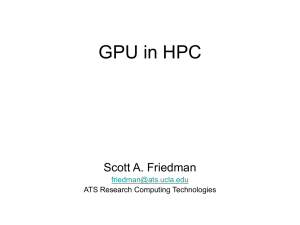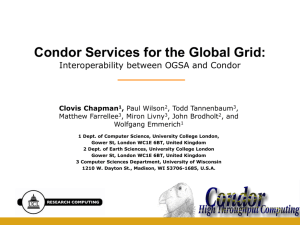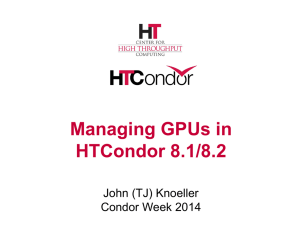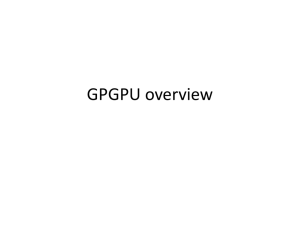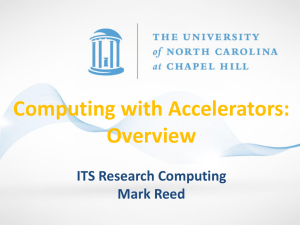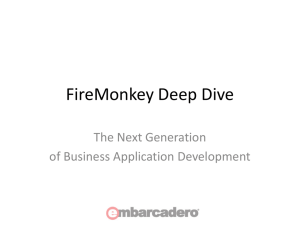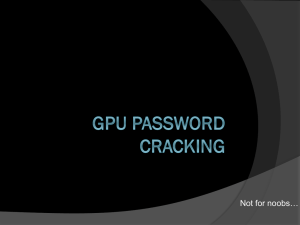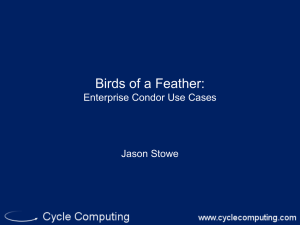PowerPoint
advertisement
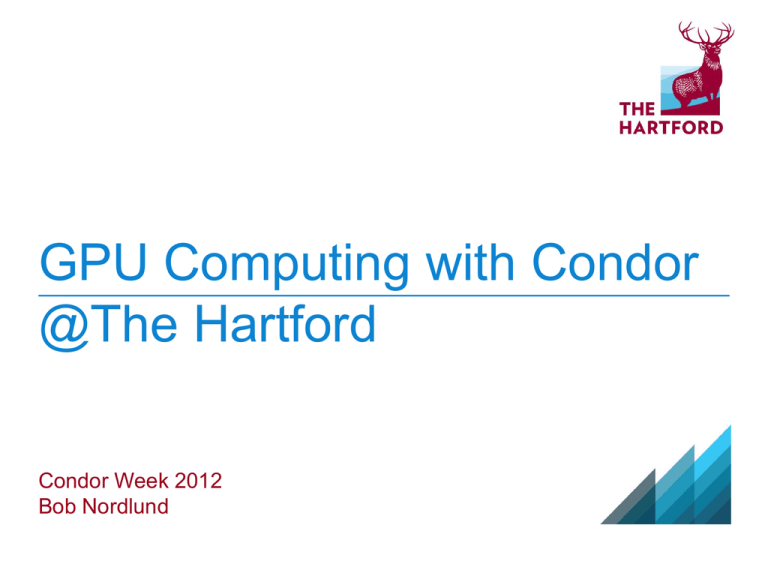
GPU Computing with Condor @The Hartford Condor Week 2012 Bob Nordlund Grid Computing @The Hartford… • Using Condor in our production environment since 2004 • Computing Environment – Two pools (Hartford, CT and Boulder, CO) – Linux central managers and schedulers – Windows execute nodes (~7000 cores) – CycleServer from Cycle Computing LLC • Workload – Mix of off-the-shelf tools and in-house custom software – Actuarial modeling – Financial reporting – Compliance – Enterprise risk management – Hedging – Stress testing 2 The Challenge… • Compress the time it takes to compute market sensitivities to enable rapid response to large market movements – Current compute time: ~8 hours on ~3000 cores – Target: A.S.A.P.(P being practical) • Compress the time it takes to simulate our hedging program – Current compute time: ~5 days on ~5000 cores – Target: 1 day • Create a mechanism to calculate specific sensitivities in near real time • Support Entire Model Portfolio: ~20 models • Maintain Accuracy and Precision • Enterprise IT Targets – Reduce Datacenter Footprint – Reduce Costs 3 The Approach…(everything’s on the table) • Modeling – Variance Reduction – Optimize algorithms – Eliminate Redundant or Un-necessary Work • Processes – Optimize submission pipeline – Reduce file transfers – Implement Master/Worker framework • Models – Optimize code – Caching – Dynamic scenario generation – CUDA/OpenCL/OpenMP • Infrastructure – Improve storage – GPUs 4 The Plan… • Modeling – Test convergence with low-discrepancy sequences – Evaluate closed-form or replicating portfolio approach – Remove un-necessary workload • Processes – Interleave scenario/liability/asset submissions – Improve nested stochastic analysis – Develop Master/Worker scheduling • Models – Port model portfolio to CUDA – Optimize algorithms • Purchase GPU Infrastructure – 250 NVIDIA Tesla 2070s 5 The Results… • Modeling – Convergence achieved faster with low-discrepancy sequences – 2x improvement – Removed non-essential tasks – 2x improvement • Processes – Streamlined submission pipeline for scenario/liability/assets – Eliminated ~1TB/run of file transfer – Using Work Queue for Master/Worker – 4-6x improvement 6 The Results (cont.)… • Models – Developed code generator for CUDA – Automated development and end-user automation (priceless!) – Directly Compiled Spec Models – Ported entire model portfolio to CUDA (GPU) and C++ (CPU) – 40-60x improvement • Infrastructure – 125 Servers with 250 M2070s – 3x reduction in data center footprint – 50% cost reduction • Summary – Success! – Improved Performance – Reduced Cost – Improved our long-term capabilities 7 What’s Next? Complete integration of GPUs into our Condor environment • Quickly find the GPU nodes – GPU = “None” – SLOT1_GPU =“NVIDIA” – SLOT2_GPU=“NVIDIA” – STARTD_EXPRS = $(STARTD_EXPRS), GPU • Identify GPGPU submissions – +GPGPU=True • Reserve Slots for GPGPU jobs – START=( ( ( SlotID < 3 ) && ( GPUGPU =?= True ) ) || ( (SlotID > 2) && (GPGPU =!= True) ) ) • Work with Todd on GPU wish list – Benchmarking – Monitoring (corrupt memory, etc.) 8 What’s Next? Refine our job scheduling architecture • Minimize Scheduling Overhead – Continue development on our Work Queue implementation – Leverage new Condor features – key_claim_idle? • Optimize Work Distribution – Need to prevent starvation of fast GPU resources while still leveraging existing dedicated and scavenged CPUs – Integrate with CycleServer • High-availability/disaster recovery – Persistent queues – Support for multiple resource pools 9 What’s Next? Expand Condor’s footprint @The Hartford • Condor for Server Utilization Monitoring – Install Condor on all servers – Improved reporting and, – Foot-in-the-door for scavenging! • Condor in the Cloud • Condor Interoperability (MS HPC Server) • Evangelize Condor to ISVs 10 Thank you! Bob Nordlund Enterprise Risk Management Technology The Hartford robert.nordlund@thehartford.com 11

